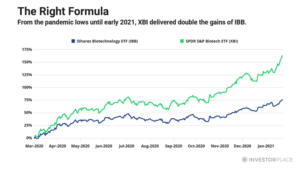
Hello, Reader.
A polarizing debate has long plagued the nation, even the world…
Which flavor is better, chocolate or vanilla?
Hard stances are usually taken. Chocolate lovers never bend, and vanilla enthusiasts remain, well, enthusiastic. I myself am a hard-core vanilla guy.
When an industry booms, or a megatrend surfaces, the resulting investment opportunities can be as different as these popular, divisive flavors. It’s important to find the ones that fit your taste.
Well, now that the healthcare industry has entered the “Age of AI,” the opportunities to capitalize on it are popping up like weeds in a garden, or perhaps like bacteria in a Petri dish.
The biotech sector, in particular, is offering a compelling and timely opportunity.
So, in today’s Smart Money, I’ll share two different flavors of biotech ETFs that, like chocolate and vanilla, couldn’t be more different.
A Tale of Two Flavors
Now, investing in the high-risk biotech sector can be a confusing and challenging endeavor.
You might assume, for example, that buying one of the leading biotech ETFs would be a good way to go because it would diversify your risk across dozens of biotech companies.
And that assumption would be correct.
You might also assume that all biotech ETFs are created equal. But that assumption would not be correct. The two largest biotech ETFs in the U.S. market bear little resemblance to one another, other than their names.
The $7.7 billion iShares Biotechnology ETF (IBB) holds a basket of mostly “blue chip” companies like Amgen Inc. (AMGN) and Gilead Sciences Inc. (GILD). The $7.6 billion SPDR S&P Biotech ETF (XBI) holds a portfolio of relatively unknown, aspiring biotech companies.
Neither portfolio is automatically better than the other, but they are nothing alike… and their historic price histories reflect their differences.
When animal spirits are running hot in the stock market, the speculative XBI portfolio outperforms the relatively conservative IBB portfolio by a wide margin.
As the chart below shows, XBI soared 163% from the pandemic lows of 2020 to the speculative peak of early 2021 – more than double IBB’s 76% gain over the same timeframe.

But that scalpel cuts both ways. From its 2021 peak, XBI tumbled more than 50% over the following 12 months, compared to IBB’s loss of just 28%.
XBI subjects investors to a lot more turbulence than IBB does because its portfolio is a lot more speculative than IBB’s. The difference between the two is striking.
Only one of the “Top 10” holdings in the XBI portfolio booked a profit during the last 12 months. Collectively, those ten stocks produced an annual loss of $3 billion.
By contrast, eight of the “Top 10” stocks in the IBB portfolio produced a profit during the last 12 months. Collectively, those ten stocks produced an annual profit of $18 billion.
Again, neither ETF is automatically better than the other, but investors should understand the differences between them before investing.
Furthermore, investors should understand that investing in any type of biotech stock or ETF can be a risky and/or frustrating endeavor.
During the last 10 years, for example, the S&P 500 Index has delivered nearly triple the gain of IBB and four times the gain of XBI.
Drug development is hard… and costly.
Only 12% of the new molecular entities that enter clinical trials receive eventual FDA approval, according to the Pharmaceutical Research and Manufacturers of America (PhRMA).
As for the cost of bringing a drug to market, PhRMA puts the price tag at $2.6 billion, over a lengthy 10- to 15-year development period.
Because of this daunting risk-reward profile, biotech stocks do not offer reliable investment opportunity.
But I believe AI could revolutionize the economics of drug discovery…
AI’s Biotech Boost
First, AI could boost the success rates of new therapies by pre-qualifying potential drug candidates more expertly than traditional trial-and-error processes could.
Second, it could reduce the average expense and timeline of advancing these candidates through clinical trials by shortening the drug-development timeframe.
Perhaps that’s why all 10 of the top positions in the iShares Biotechnology ETF are actively integrating some facet of AI into their drug-development processes.
Meanwhile, many of the biggest pharmaceutical companies in the world are paying tens of billions of dollars to snap up promising, albeit profitless, biotech companies. You could call it a biotech gold rush.
Presumably, the “crazy” prices major pharmaceutical companies are paying to acquire early-stage biotech companies aren’t crazy at all. The acquiring companies must believe that they can utilize AI to quickly convert the profitless potential of their biotech acquisitions into robust profitability.
I trust their collective judgement, and believe that the biotech industry, in the aggregate, will reap handsome rewards from the expansion of AI in healthcare. Specifically, I expect a growing number and variety of AI-derived therapies to enter clinical trials during the next couple of years.
To capitalize on the biotech industry’s outsized potential in an AI-enabled world, I suggest taking a position in the biotech ETF that best suits your risk appetite, whether that be XBI or IBB.
The Future is Here
I want to emphasize that, while biotech and AI can be a dicey investment, what comes next could be transformative. AI is the future, but it’s happening right now.
“The most disruptive force in history,” has been disrupting the healthcare industry – for the better. That’s because the whole purpose of AI is to create an intelligence that exceeds our own…
So, it’s impossible for humans to truly fathom what an AI-driven future will bring.
And AI seems ready to transform every field, or flavor, it expands into.
We’re reaching a technological tipping point… one that calls for an AI Code Red.
If you want the chance to end up on the winning side of AI’s disruptive force, click here for all the details.
Regards,
Eric Fry




